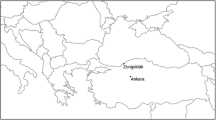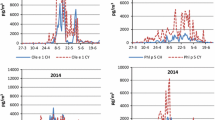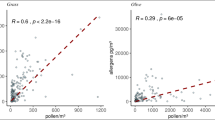Abstract
The allergens of different grass species share similar physicochemical and immunological features that account for the high incidence of allergenic cross-reactivity. We aimed to gain more information on the correlation between Poaceae airborne pollen and allergen concentration and hence make a reliable assessment of true pollen exposure in different bioclimatic areas. The release of Lol p 1 allergen from grass pollen differs between years and areas depending on variables like meteorological factors, biological sources, and cross-reactions with homologous allergens. This study monitored airborne pollen concentrations of grasses and Lol p 1 aeroallergen in León and Ourense, two cities with different climatic conditions located in northwestern Spain. Lol p 1 content in aerosol samples was quantified using specific ELISA antibody plates. Some our results show that Lol p 1 concentration increases when the atmospheric relative humidity is below 70%. This could explain the appearance of protein peaks at times when little or no grass pollen is present, especially after a short and heavy storm.


Similar content being viewed by others
References
Andersson, K., & Lidholm, J. (2003). Characteristics and immunobiology of grass pollen allergens. International Archives of Allergy and Immunology, 130, 87–107.
Antepara, I., Fernandez, J. C., Gamboa, P., Jaurefui, I., & Miguel, F. (1995). Pollen allergy in the Bilbao area (European Atlantic seaboard climate): Pollination forecasting methods. Clinical & Experimental Allergy, 25, 133–140.
Arilla, M. C., Ibarrola, I., Eraso, E., Aguirre, M., Martínez, A., & Asturias, J. A. (2001). Quantification in mass units of group 1 grass allergen by a monoclonal antibody-based sandwich ELISA. Clinical & Experimental Allergy, 31, 1271–1278.
Asturias, J. A., Ibarrola, I., Bartolome, B., Ojeda, I., Malet, A., & Martinez, A. (2002). Purification and characterization of Pla a 1, a major allergen from Platanus acerifolia pollen. Allergy, 57, 221–227.
Cabrera, M., Martínez-Cócera, C., Fernández Caldas, E., Carnés-Sanchez, J., Boluda, L., Tejada, J., et al. (2002). Trisetum paniceum (Wild Oats) pollen counts and aeroallergens in the ambient air of Madrid, Spain. International Archives of Allergy and Immunology, 128, 123–129.
Casas, C., Márquez, J., Suárez Carvera, M., & Seoane Camba, J. A. (1996). Immunocytochemical localization of allergenic proteins in Pariateria judaica L. (Urticaceae). European Journal of Cell Biology, 70, 179–188.
Cosgrove, D. J., Bedinger, P., & Durachko, D. M. (1997). Group I allergens of grass pollen as cell wall-loosening agents. Proceedings of the National Academy of Sciences, 94, 6559–6564.
D’Amato, G., Spieksma, F. T. M., & Bonini, S. (Eds.). (1991). Allergenic pollen and pollinosis in Europe. Oxford, UK: Blackwell Scientific Publications.
D’Amato, G., Cecchi, L., Bonini, S., Nunes, C., Annesi-Maesano, I., Behrendt, H., et al. (2007). Allergenic pollen and pollen allergy in Europe. Allergy, 62, 976–990.
De Linares, C., Nieto Lugilde, D., Alba, F., Diaz de la Guardia, C., Galán, C., & Trigo, M. (2007). Dectection of airborne allergen (Ole e 1) in relation to Olea europaea pollen in S. Spain. Clinical & Experimental Allergy, 37, 125–132.
De Linares, C., Díaz de la Guardia, C., Nieto Lugilde, D., & Alba, F. (2010). Airborne study of grass allergen (Lol p 1) in different-sized particles. International Archives of Allergy & Immunology;, 152, 49–57.
Emberlin, J. C. (1997). Grass, tree and weed pollen. In B. Kay (Ed.), Allergy and allergic diseases (pp. 845–857). Oxford: Blackwell Scientific.
Fernandez Caldas, E., Bandele, E. O., Dunnette, S. L., Swanson, M. C., & Reed, C. E. (1992). Rye grass group allergen content in leaves from seven different grass species. Grana, 31, 157–159.
Fernández-González, D., Valencia-Barrera, R. M., Vega, A., Díaz de la Guardia, C., Trigo, M. M., Cariñanos, P., et al. (1999). Analysis of grass pollen concentrations in the atmosphere of several Spanish sites. Polen, 10, 123–132.
Fernández-González, D., Rodríguez-Rajo, J., González-Parrado, Z., Arias, S., Valencia-Barrera, R., Moreno-Grau, S., et al. (2008). Relationship between Poaceae pollen counts and the quantification of the Lol p 1 allergen atmospheric content. Allergy, 63(s88), 548–549.
Galan, C., Cariñanos, P., Alcázar, P., & Dominguez, E. (2007). Spanish aerobiology network: Management and quality manual. USA: University of Córdoba.
Garcıa-Mozo, H., Galan, C., Belmonte, J., Bermejo, D., Candau, P., Dıaz de la Guardia, C., et al. (2009). Predicting the start and peak dates of the Poaceae pollen season in Spain using process-based models. Agricultural and Forest Meteorology, 149, 256–262.
Grobe, K., Becker, W. M., Schlaak, M., & Petersen, A. (1999). Grass group I allergens (b-expansins) are novel, papain-related proteinases. European Journal of Biochemistry, 263, 33–40.
Grote, M., Vrtala, S., Niederberger, V., Valenta, R., & Reichelt, R. (2000). Expulsion of allergen-containing materials from hydrated rye grass (Lolium perenne) pollen revealed by using immunogold field emission scanning and transmisssion electron microscopy. Journal of Allergy and Clinical Immunology, 105(6), 1140–1145.
Grote, M., Valenta, R., & Reichelt, R. (2003). Abortive pollen germination: a mechanism of allergen release in birch, alder and hazel revealed by immunogold electron microscopy. Journal of Allergy and Clinical Immunology, 111, 1017–1023.
Herbert, C. A., King, C. M., Ring, P. C., Holgate, S. T., Stewart, G. A., Thompson, P. J., et al. (1995). Augmentation of permeability in the bronchial epithelium by the house dust mite allergen Der p1. American Journal of Respiratory Cell and Molecular Biology, 12(4), 369–378.
Jato, V., Rodríguez-Rajo, F. J., Seijo, M. C., & Aira, M. J. (2009). Poaceae pollen in Galicia (N.W. Spain): Characterization and recent trends in atmospheric pollen season. International Journal of Biometeorology, 53, 333–344.
Mari, A. (2003). Skin test with a timothy grass (Phleum pratense) pollen extract vs. IgE to a timothy extract vs. IgE to rPhl p 1, rPhl p 2, nPhl p 4, rPhl p 5, rPhl p 6, rPhl p 7, rPhl p 11, and rPhl p 12: Epidemiological and diagnostic data. Clinical & Experimental Allergy, 33, 43–51.
Marquez, J., Seoane-Camba, J. A., & Suarez-Cervera, M. (1997). Allergenic and antigenic proteins released in the apertural sporoderm during the activation process in grass pollen grains. Sexual Plant Reproduction, 10, 269–278.
Moreno Grau, S., Elvira-Rendueles, B., Moreno, J., García-Sanchez, A., Vergara, N., Asturias, J., et al. (2006). Correlation between Olea europaea and Parietaria judaica pollen counts and quantification of their major allergens Ole e 1 and Par j 1-Par j 2. Annals of Allergy, Asthma & Inmunology, 96, 858–864.
Nasrallah, J. B. (2000). Cell-cell signaling in the self-incompatibility response. Current Opinion in Plant Biology, 3, 368–373.
Radauer, C., & Breiteneder, H. (2006). Pollen allergens are restricted to few protein families and show distinct patterns of species distribution. Journal of Allergy and Clinical Immunology, 117, 141–147.
Rantio-Lehtimaki, A., Koivikko, A., Kupias, R., Makinen, Y., & Pohjola, A. (1991). Significance of sampling height of airborne particles for aerobiological information. Allergy, 46, 68–76.
Rodríguez Rajo, F. J., Jato, V., González Parrado, Z., Elvira-Rendueles, B., Moreno Grau, S., Vega Maray, A. M., Fernández-González, D., Asturias, J. A., & Suárez-Cervera, M. (2010). The combination of airborne pollen and allergen quantification to reliably assess the real pollinosis risk in different bioclimatic areas. Aerobiologia. doi:10.1007/s10453-010-9170-2.
Sanchez, A. M., Bosch, M., Bots, M., Nieuwland, J., Feron, R., & Mariani, C. (2004). Pistil factors controlling pollination. The Plant Cell, 16, 98–106.
Schäppi, G. F., Monn, C., Wüthrich, B., & Wanner, H. U. (1996). Analysis of allergens in ambient aerosols: Comparison of areas subjected to different levels of air pollution. Aerobiologia, 12, 185–190.
Solomon, W. R., Burge, H. A., & Muilenberg, M. L. (1983). Allergen carriage by atmospheric aerosol, I: Ragweed pollen determinants in smaller micronic fractions. Journal of Allergy and Clinical Immunology, 72, 443–447.
Spieksma, F. Th. M., Nikkels, B. H., & Dijkman, J. H. (1995). Seasonal appearance of grass pollen allergen in natural, pauci-micronic aerosol of various size fractions. Relationship with airborne grass pollen concentration. Clinical & Experimental Allergy, 25, 234–239.
Takahashi, Y., Ohashi, T., Nagoya, T., Sakaguchi, M., Yasueda, H., & Nitta, H. (2001). Possibility of real-time measurement of an airborne Cryptomeria japonica pollen allergen based on the principle of surface plasmon resonance. Aerobiologia, 17(4), 313–318.
Vega Maray, A. M., Fernández-González, D., Valencia-Barrera, R. M., & Suárez-Cervera, M. (2006). Detection and release of allergenic proteins in Parietaria judaica pollen grains. Protoplasma, 228, 115–120.
Weber, R. W. (2004). Cross-reactivity of pollen allergens. Current Allergy and Asthma Reports, 4, 401–408.
Weber, R. W. (2007). Cross-reactivity of pollen allergens: Impact on allergen immunotherapy. Annals of Allergy, Asthma & Imunology, 99, 203–212.
Acknowledgments
The authors are grateful to Juan Asturias from Bial-Arístegui Spain for technical support and Anne Collins for editing the English text. This study was supported by grant CGL2006-15103-C04-03, Department of Science and Technology, and grant LE044A07, Junta de Castilla y León. Spain.
Author information
Authors and Affiliations
Corresponding author
Rights and permissions
About this article
Cite this article
Fernández-González, D., Rodriguez Rajo, F.J., González Parrado, Z. et al. Differences in atmospheric emissions of Poaceae pollen and Lol p 1 allergen. Aerobiologia 27, 301–309 (2011). https://doi.org/10.1007/s10453-011-9199-x
Received:
Accepted:
Published:
Issue Date:
DOI: https://doi.org/10.1007/s10453-011-9199-x




